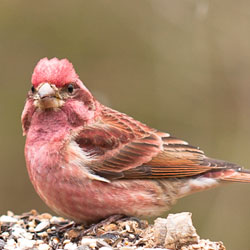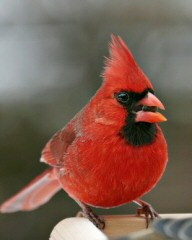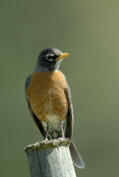Common Birds: Red and Red-ish Birds

Male Purple Finch
House Finch & Purple Finch: 5 to 5 3/4 " in size. These two birds are often seen at bird feeders. They are small, sparrow sized, brownish red or purple-ish birds. The males have varying amounts of red on the head, back and breast. Male house finches and purple finches are hard to tell apart. The best way to tell the difference is to look at their sides. The male House Finch has heavy brown streaks on his sides and the male Purple Finch does not. The male Purple Finch also has a purple-ish color wash over most of its body while the finch's more reddish color is primarily on the head and chest. The females of these two species are easier to tell apart. The Purple Finch female has a white eyebrow streak and the female House Finch does not.
Food: Both House and Purple Finches are seed eaters. They come to bird feeders and eat sunflower and thistle seeds.
Range: House finches are permanent residents of the West. They were introduced in New York City in the 1940s, have spread throughout most of the East, and their range continues to expand. Purple finches are resident in much of the northern United States and on the Pacific Coast. In winter, they range throughout most of the eastern half of the United States.
More info: Telling the red finches apart.

Northern Cardinal: 7 1/2 to 9 1/2 " in size. The Cardinal is a beautiful, red, crested bird, with a red-orange beak. The male is all red, with a black face. The female is a brownish color with red on the wings, tail, and crest.
;
Food: Cardinals eat seeds and fruits. Cardinals can be attracted to feeders with sunflower seeds, safflower seed, and cracked corn.
Range: The Cardinal is a permanent resident of the eastern half of the United States and into Texas, Arizona, and New Mexico.
More info: Northern Cardinal at Cornell Lab of Ornithology.

Robin: 10" in size. The Robin has a brownish back and a red breast. Males are darker than females. They are a common sight on lawns and in parks.
Food: Robins eat worms, insects, and berries. Robins do not usually come to bird feeders, but may be attracted to raisins.
Range: Robins breed across the entire United States. Winter range includes most of the country, except the northern plains, northern Midwest, and northern New England.
More info: American Robin at Cornell Lab of Ornithology.
Have you seen a solid red bird that isn't a Cardinal?
The Summer Tanager is not a common backyard bird but if you live in a wooded area, you might see one, particularly if you have a bird bath or water feature. These birds love a good bath!
Adult male Summer Tanagers are solid red. Females are a greenish yellow. First year males (born last spring) may be a mix of yellow and red!
The video below provides a good look at these beautiful birds and you can also hear their distinctive call.
Find the best bird guides - reviewed by users - at Amazon.com
